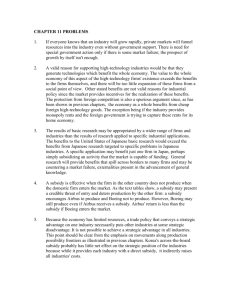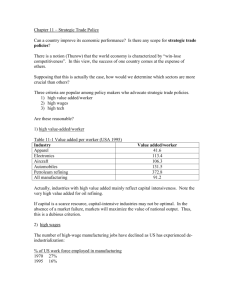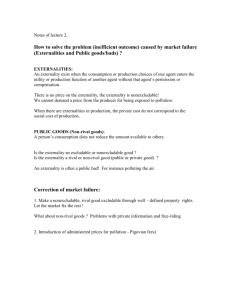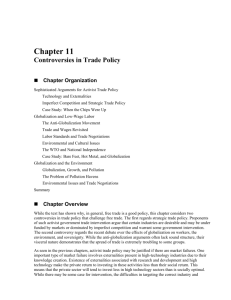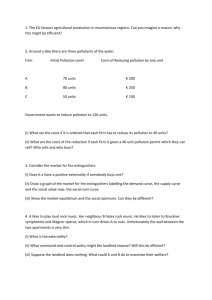Word Document
advertisement
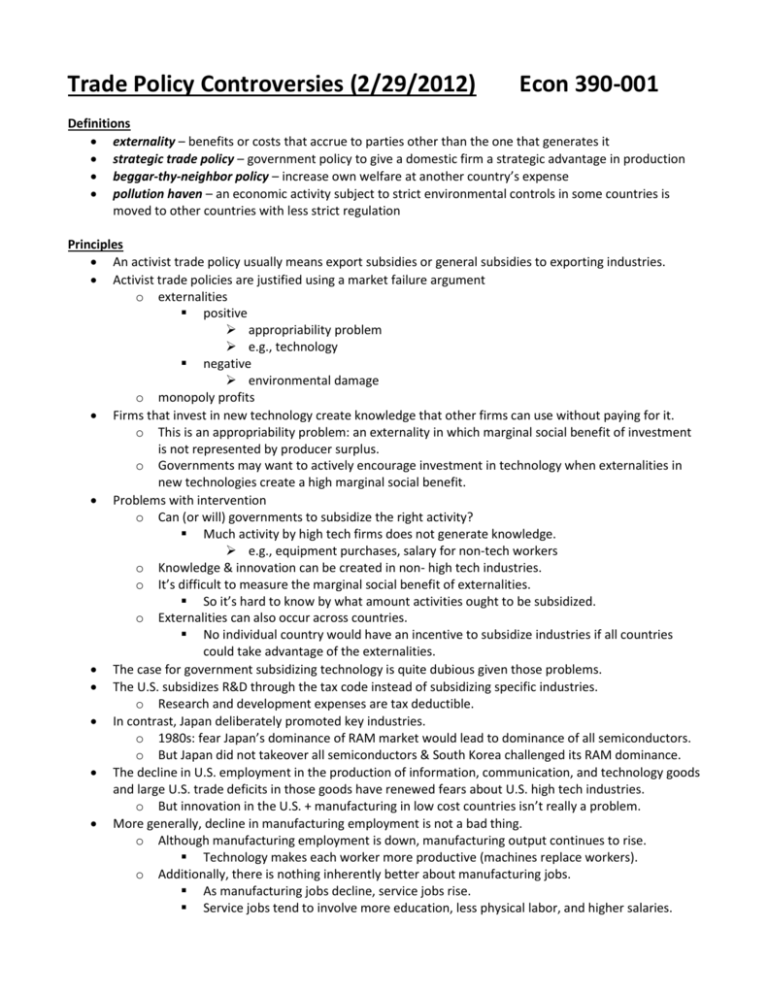
Trade Policy Controversies (2/29/2012) Econ 390-001 Definitions externality – benefits or costs that accrue to parties other than the one that generates it strategic trade policy – government policy to give a domestic firm a strategic advantage in production beggar-thy-neighbor policy – increase own welfare at another country’s expense pollution haven – an economic activity subject to strict environmental controls in some countries is moved to other countries with less strict regulation Principles An activist trade policy usually means export subsidies or general subsidies to exporting industries. Activist trade policies are justified using a market failure argument o externalities positive appropriability problem e.g., technology negative environmental damage o monopoly profits Firms that invest in new technology create knowledge that other firms can use without paying for it. o This is an appropriability problem: an externality in which marginal social benefit of investment is not represented by producer surplus. o Governments may want to actively encourage investment in technology when externalities in new technologies create a high marginal social benefit. Problems with intervention o Can (or will) governments to subsidize the right activity? Much activity by high tech firms does not generate knowledge. e.g., equipment purchases, salary for non-tech workers o Knowledge & innovation can be created in non- high tech industries. o It’s difficult to measure the marginal social benefit of externalities. So it’s hard to know by what amount activities ought to be subsidized. o Externalities can also occur across countries. No individual country would have an incentive to subsidize industries if all countries could take advantage of the externalities. The case for government subsidizing technology is quite dubious given those problems. The U.S. subsidizes R&D through the tax code instead of subsidizing specific industries. o Research and development expenses are tax deductible. In contrast, Japan deliberately promoted key industries. o 1980s: fear Japan’s dominance of RAM market would lead to dominance of all semiconductors. o But Japan did not takeover all semiconductors & South Korea challenged its RAM dominance. The decline in U.S. employment in the production of information, communication, and technology goods and large U.S. trade deficits in those goods have renewed fears about U.S. high tech industries. o But innovation in the U.S. + manufacturing in low cost countries isn’t really a problem. More generally, decline in manufacturing employment is not a bad thing. o Although manufacturing employment is down, manufacturing output continues to rise. Technology makes each worker more productive (machines replace workers). o Additionally, there is nothing inherently better about manufacturing jobs. As manufacturing jobs decline, service jobs rise. Service jobs tend to involve more education, less physical labor, and higher salaries. Imperfectly competitive industries are typically dominated by a few firms with monopoly profits. o But government subsidies can shift monopoly profits from a foreign firm to a domestic firm. Brander-Spencer analysis (strategic trade policy with game theory) o Setup Two firms compete in the international market but are located in different countries. Each firm’s profits depends on the actions of the other. Each firm decides to produce or not depending on profits. o Insights The predicted outcome depends on which firms invest/produce first. If Boeing produces first, then Airbus won’t produce. If Airbus produces first, then Boeing won’t produce. o Twist: strategic trade policy in the form of a subsidy A subsidy(+25) by the European Union can alter the outcome. Makes it profitable for Airbus to produce regardless of Boeing’s action. Boeing will then be deterred from entering the industry. The EU subsidy of 25 gives Airbus profits of 125. Here the subsidy raises profits more than the amount of the subsidy. This is due to its deterrent effect on foreign competition. Criticisms of strategic trade policy o requires too much information about firms o foreign governments could retaliate o manipulable by politically powerful groups Compared to rich-country standards, environmental standards in developing countries are very lax. o Some oppose free trade because of increased production increases in these countries. Environmental activists want environmental standards to be part of trade negotiations. o But developing countries oppose such standards. o Standards can be used as an excuse for protectionism. o Resentment: developed countries such as the United States had lax environmental standards during their growth, but now want to make growth harder for developing countries. Environmental Kuznets curve o As poor countries grow richer they produce more and can consume more. Increasing environmental damage (left side of curve). o But as countries grow richer, they want to pay for more environmental protection. Reducing environmental damage (right side of curve). o The environmental Kuznets curve shows being green is a normal good. People demand more of it as income goes up. Best way to improve environment long term is to increase real incomes until all are rich. Pollution havens o Evidence shows the pollution haven effect on international trade is relatively small. Production that seems to move for pollution havens more often attracted to low wages. o To the extent that pollution is limited to a country, it isn’t other countries’ problem. When it causes a negative externality for others, include it in trade negotiations. Air pollution in Mexico City is a problem for Mexico, not the United States. o A better case can be made that global warming affects all countries. Unilaterally limiting carbon emissions from the U.S. would have little effect because production would shift to other countries (like China) in a pollution haven effect. Only taxes or tariffs applied to the whole world could effectively curb it. Cure may be worse than disease: lower growth rates (e.g., right side of Kuznets). Environmental Kuznets curve manufacturing jobs in the U.S. by year
